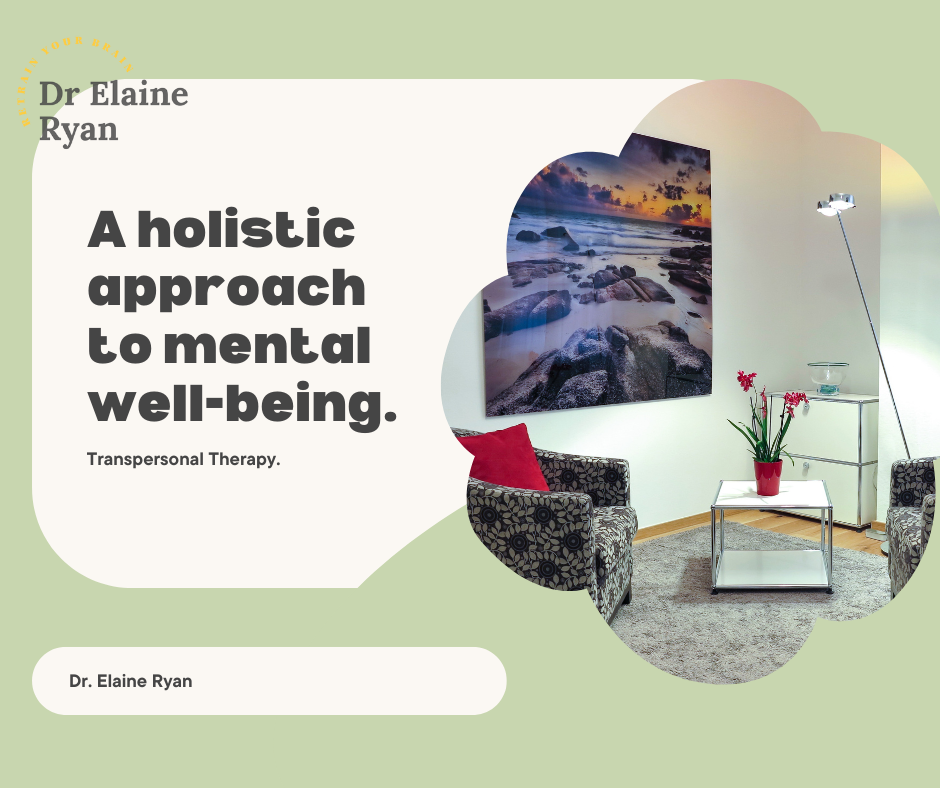Transpersonal therapy offers a unique approach to inner healing and self-realization, and I first experienced this style of therapy (in personal therapy) during my PsychD training.
Transpersonal Therapy, rooted in transpersonal psychology, goes beyond the ego. It explores consciousness, spiritual experiences, and the potential for personal growth.
This therapy is not just about addressing mental health issues. It’s about expanding awareness, integrating spiritual insights, and fostering holistic wellness.
If you have attended therapy with me in the past and now wondering why you were not offered transpersonal therapy, the reason is simple. Most people come to see me for anxiety disorders and OCD, and CBT and ERP are the widely used and most effective therapies for those problems.

What is Transpersonal Therapy?
Transpersonal Therapy is a form of psychotherapy that emphasizes spiritual growth and self-realization. It’s a holistic approach that considers the whole person, not just their mental health issues.
This therapy is grounded in the principles of transpersonal psychology. This branch of psychology explores the spiritual aspects of human experience. It delves into realms of consciousness beyond the ego. If you are new to transpersonal psychology VerywellMind offers a good introduction explaining how the model does not limit itself to one school of thought.
Transpersonal Therapy integrates Eastern philosophies and Western psychology. It values mindfulness, presence, and the exploration of altered states of consciousness. Techniques such as meditation, guided imagery, and breathwork are often used.
The goal of Transpersonal Therapy is not just to alleviate symptoms. It aims to expand awareness, integrate spiritual insights, and foster personal growth. It’s about helping individuals realize their fullest potential.
In essence, Transpersonal Therapy is a journey towards inner healing and self-realization. It’s a path that can lead to profound transformations in one’s life and relationships.
The Historical Context of Transpersonal Psychology
Transpersonal psychology emerged in the mid-20th century. It was a response to the limitations of traditional psychology. The pioneers of this field sought to explore the spiritual dimensions of human experience.
Abraham Maslow, a key figure in humanistic psychology, was instrumental in its development. He introduced the concept of “peak experiences”. These are moments of profound joy, wonder, or awe that transcend ordinary consciousness. You probably don’t know that I have danced for 40 years, and hopefully this example will help you understand peak experiences. When dancing with a partner, I do not have to think; I am completely caught up in the dance, in the flow. Musicians also can experience this easily be lost in a piece of music.
Stanislav Grof, a psychiatrist and researcher, also contributed significantly. His work on altered states of consciousness and psychedelic therapy laid the groundwork for many transpersonal practices.
I studied Maslow (you may well have heard of his hierarchy of needs) and Grof in my first year of my doctoral training and have used them to inform my practise ever since.
Transpersonal psychology has since evolved into a rich and diverse field. It continues to influence many areas of mental health, personal growth, and spiritual development.
Key Figures and Influences in Transpersonal Therapy
Abraham Maslow is often credited as the father of transpersonal psychology. His hierarchy of needs, culminating in self-actualization, laid the foundation for this therapeutic approach. Maslow’s work emphasized the importance of peak experiences and personal growth.
Stanislav Grof is another influential figure in this field. His research on non-ordinary states of consciousness, particularly those induced by psychedelics, has greatly influenced transpersonal therapy. Grof’s work has helped to validate the therapeutic potential of spiritual experiences.
Other influences include Eastern philosophies and practices such as meditation and mindfulness. These have been integrated into transpersonal therapy to facilitate self-realization and inner healing.
Core Principles of Transpersonal Therapy
Transpersonal therapy is built on four fundamental premises. These principles guide the therapeutic process and distinguish this approach from other forms of psychotherapy.
- The first principle is the recognition of a transcendent dimension to human experience. This dimension, often described as spiritual or divine, is considered essential to our psychological well-being.
- The second principle is the potential for self-realization. Transpersonal therapy aims to help individuals realize their true nature, beyond the limitations of the ego.
- The third principle is the integration of Eastern and Western psychological theories. This holistic approach acknowledges the value of both introspective practices and scientific research.
- The final principle is the importance of direct experience. Transpersonal therapy emphasizes experiential learning, encouraging individuals to explore their own consciousness.
These principles form the foundation of transpersonal therapy, guiding its practices and therapeutic goals.
Techniques and Practices in Transpersonal Therapy
Transpersonal therapy employs a variety of techniques to facilitate inner healing and self-realization. These practices are designed to expand awareness and integrate spiritual insights.
- Meditation is a key practice in transpersonal therapy. It helps individuals cultivate mindfulness and presence, which are essential for inner transformation.
- Guided imagery is another technique often used. It allows individuals to explore their subconscious mind and uncover hidden insights.
- Breathwork is also a common practice. It can induce altered states of consciousness and facilitate peak experiences.
- Bodywork and somatic practices are also incorporated. These techniques help individuals connect with their physical sensations and emotions.
- Art and creative expression are also encouraged. They provide a non-verbal outlet for expressing inner experiences.
These techniques, among others, are used in transpersonal therapy to facilitate inner healing and personal growth. They are tailored to the individual’s needs and preferences, ensuring a personalized therapeutic experience.
The Therapeutic Goals of Transpersonal Therapy
The primary goal of transpersonal therapy is to facilitate self-realization and personal growth. This involves expanding one’s awareness beyond the ego and integrating spiritual insights into everyday life.
Another important goal is to heal trauma and address various mental health issues. Transpersonal therapy aims to activate the “inner healer,” allowing individuals to find their own path to psychological wellness.
Lastly, transpersonal therapy seeks to foster a holistic approach to well-being. This includes nurturing physical health, cultivating positive relationships, and promoting creative expression. In essence, it’s about helping individuals live more fulfilling and meaningful lives.
Transpersonal Therapy in Practice: What to Expect
In a typical transpersonal therapy session, the therapist facilitates a safe and supportive environment. This allows the individual to explore their inner world and access higher states of consciousness.
Various techniques may be used, including meditation, guided imagery, and breathwork. The specific methods employed will depend on the individual’s needs and the therapist’s expertise.
It’s important to note that transpersonal therapy is a journey, not a quick fix. It requires patience, openness, and a willingness to delve into the depths of one’s psyche. The rewards, however, can be profound and life-changing.
The Benefits of Transpersonal Therapy for Inner Healing
Transpersonal therapy offers a holistic approach to healing, addressing not only the mind but also the spirit. It can help individuals navigate life transitions, overcome trauma, and resolve existential crises.
By fostering self-realization and personal growth, transpersonal therapy can lead to improved psychological wellness. It can enhance self-esteem, cultivate empathy, and foster a sense of purpose and meaning in life.
Moreover, the insights gained through transpersonal therapy can positively impact personal relationships and community building. It can also contribute to global healing and transformation, underscoring its far-reaching benefits.
Finding a Qualified Transpersonal Therapist
Finding a qualified transpersonal therapist requires careful consideration. It’s important to look for a therapist with the necessary training and qualifications in transpersonal therapy.
Additionally, the therapist should demonstrate cultural sensitivity, maintain confidentiality, and build a strong patient-therapist rapport. These are crucial elements in creating a safe and supportive therapeutic environment.
Lastly, consider the therapist’s approach to personal development. A good transpersonal therapist should be committed to their own ongoing growth and learning. This commitment reflects their dedication to the therapeutic process and their ability to guide others on their healing journey.
Conclusion: Integrating Transpersonal Insights into Everyday Life
Transpersonal therapy offers profound insights that can be integrated into everyday life. These insights can lead to increased self-awareness, improved relationships, and a deeper sense of purpose.
Moreover, the practices and techniques learned in therapy, such as mindfulness and meditation, can be used outside the therapeutic setting. They can help manage stress, cultivate empathy, and foster personal growth.
In conclusion, transpersonal therapy is not just a form of therapy. It’s a holistic approach to life that promotes inner healing, self-realization, and spiritual development. It’s a journey towards a more conscious and fulfilling life.

